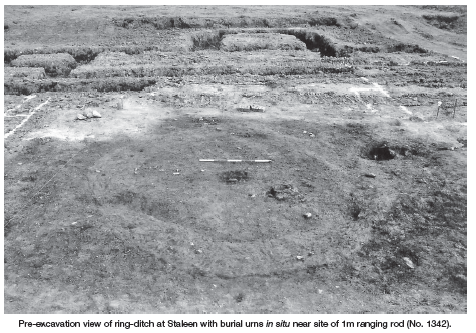County: Meath Site name: STALLEEN
Sites and Monuments Record No.: N/A Licence number: 04E0625
Author: Kieran Campbell
Site type: Ring-ditch
Period/Dating: Bronze Age (2200 BC-801 BC)
ITM: E 703040m, N 773064m
Latitude, Longitude (decimal degrees): 53.697103, -6.439652
Monitoring took place on 4–5 May 2004 during topsoil-stripping on a site for a dwelling house at Staleen (officially Stalleen), 1.5km west of the village of Donore. The site lies within the area of the Boyne Valley Archaeological Park but is not close to any of the known monuments, the nearest being a thatched vernacular mill 300m to the west. Dowth passage tomb is on the horizon, 1km to the north-west, and Newgrange is visible 2.4km to the west.
The outlines of three pottery vessels were exposed on the surface of the stripped ground, with cremated bone visible in the fills. Excavation of the site established that the burials were within a small ring-ditch, 4.2m in external diameter. The U-sectioned ditch was 0.7-0.8m wide and up to 0.46m deep. Only the base and a small fragment of wall, total height 30mm, survived of a vessel at the centre of the ring-ditch. Two vessels lay contiguous, off centre, in the north-west quadrant of the ring, 0.5m from the central burial urn. These survived to heights of 120mm and 160mm, representing approximately two-thirds of their original size. A small stone disc, a natural fossil, was found between the two vessels. A few small sub-angular stones were placed against the urns. A fourth burial urn was inserted into the fill of the ditch at the outer edge on the south-west side. Although recovered by excavation, this vessel too was fragmentary and had a maximum surviving height of 115mm. A cone-shaped flint core was recovered from inside the vessel.
All four vessels were lifted in soil blocks by staff from the Conservation Department of the National Museum of Ireland and removed to Collins Barracks. Anna Brindley has reported that the flat-based undecorated urns, three with distinctive raised and augmented bases, are likely to date to the Middle or Late Bronze Age. The assistance of the National Monuments Section, DOEHLG, is acknowledged.



6 St Ultan's, Laytown, Drogheda, Co. Louth